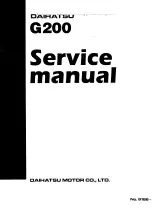
Jump Starting
If your vehicle’s battery (or batteries) has run down, you
may want to use another vehicle and some jumper
cables to start your vehicle. Be sure to use the following
steps to do it safely.
{
CAUTION:
Batteries can hurt you. They can be dangerous
because:
•
They contain acid that can burn you.
•
They contain gas that can explode or
ignite.
•
They contain enough electricity to
burn you.
If you do not follow these steps exactly, some
or all of these things can hurt you.
Notice: Ignoring these steps could result in costly
damage to your vehicle that would not be covered
by your warranty.
Trying to start your vehicle by pushing or pulling it
will not work, and it could damage your vehicle.
1. Check the other vehicle. It must have a 12-volt
battery with a negative ground system.
Notice: If the other vehicle’s system is not a 12-volt
system with a negative ground, both vehicles can
be damaged. Only use vehicles with 12-volt systems
with negative grounds to jump start your vehicle.
2. Get the vehicles close enough so the jumper cables
can reach, but be sure the vehicles are not touching
each other. If they are, it could cause a ground
connection you do not want. You would not be able
to start your vehicle, and the bad grounding
could damage the electrical systems.
To avoid the possibility of the vehicles rolling, set
the parking brake firmly on both vehicles involved
in the jump start procedure. Put the automatic
transmission in PARK (P) or a manual transmission
in NEUTRAL before setting the parking brake.
If you have a four-wheel-drive vehicle, be sure the
transfer case is in a drive gear, not in NEUTRAL.
5-40
Summary of Contents for 2008 Escalade
Page 98: ...NOTES 1 94...
Page 164: ...NOTES 2 66...
Page 167: ...NOTES 3 3...
Page 168: ...Instrument Panel Overview United States version shown Canada similar 3 4...
Page 274: ...NOTES 3 110...
Page 332: ...NOTES 4 58...
Page 448: ...NOTES 5 116...
Page 464: ...Engine Drive Belt Routing 6 16...
Page 486: ...NOTES 7 18...
















































